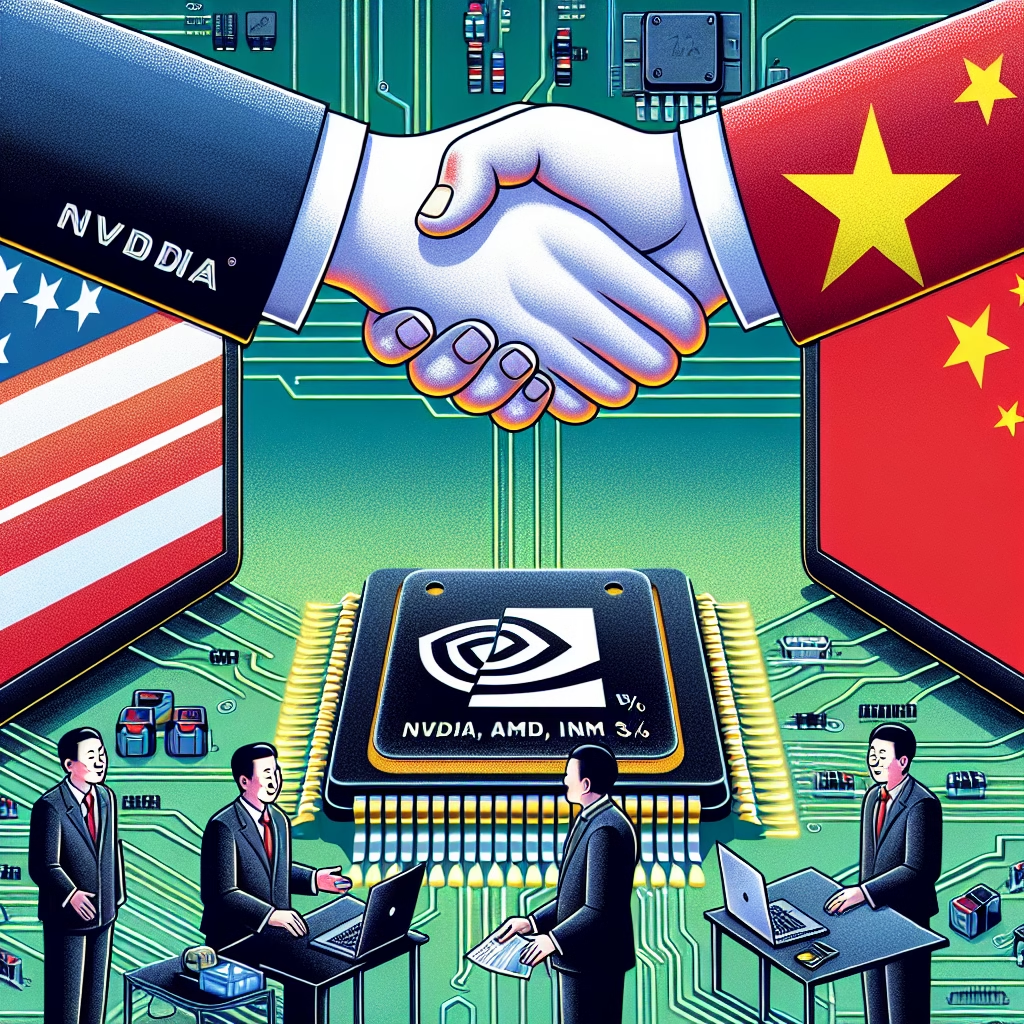Nvidia, AMD to Pay 15% of China Chip Sale Revenue Amid Washington Export Rules
US Export Controls Tighten Grip on AI Chip Makers
In a significant development for the global semiconductor industry, leading U.S. chipmakers Nvidia and AMD will now be required to pay a 15% fee on certain chip sales in China. This move comes as the United States increases export restrictions on advanced semiconductor technology, particularly artificial intelligence (AI) chips, in a bid to protect national security interests and curb China’s technological advancement in key sectors.
According to recent reports, China’s Ministry of Commerce has instructed Nvidia and AMD to fork over a 15% portion of their sales revenue from chips developed specifically for the Chinese market. This announcement marks another escalation in the ongoing U.S.-China tech conflict, with both countries vying for dominance in the lucrative AI and semiconductor sectors.
Why Is This Happening?
The U.S. government, under the Biden administration, has been imposing stricter export controls on high-end semiconductor hardware, particularly those used for military and AI purposes. The goal: prevent sensitive U.S. technologies from being used in China’s military modernization or surveillance industries.
The new rules, which took effect in late 2023, required American tech companies like Nvidia and AMD to apply for licenses to sell high-performance chips used in AI training and inference. To comply, both companies began developing lower-performance chips tailored for China that technically fall outside the scope of these regulations. However, as Beijing grows increasingly wary of its tech dependency on foreign firms, it has responded with its own set of measures.
China’s 15% Revenue Share: How It Works
Under Beijing’s latest directive:
- Nvidia and AMD must pay 15% of the revenue generated from AI chips built for Chinese clients
- The payment functions as a de facto royalty or tariff, although it is framed as a contribution toward “local technology partnerships”
- The directive currently applies only to chips developed after October 2023, though it’s expected to expand further
The fee is seen as part of China’s broader push to localize its tech supply chain and reduce dependence on foreign semiconductor firms. Chinese authorities argue the 15% levy will support domestic R&D, talent development, and innovation programs.
The Bigger Picture: Tech Cold War Intensifies
The semiconductor sector is quickly turning into the front line of what many experts call a “tech cold war” between the U.S. and China. As both countries vie for dominance in this strategically critical industry, policies are being shaped not just by market forces—but geopolitical strategy.
Implications for Nvidia and AMD
For two of the world’s biggest chipmakers, the financial and operational impact could be significant:
- Nvidia generates roughly 20% of its data center revenue from China, though exact figures remain unconfirmed
- AMD has been trying to gain more market share in Asia, and this new policy may complicate its ambitions
- Increased costs and compliance complexity may deter future China-specific designs, undermining flexibility in product design and sales strategy
Both Nvidia and AMD have expressed their commitment to complying with regulatory frameworks in both countries. However, ongoing changes pose risks not only to their current revenue streams but also to long-term strategic planning.
China’s Long-Term Strategy: Homegrown Innovation
While Western markets view China’s 15% fee as a retaliatory or protectionist tactic, officials in Beijing frame it as a “reciprocal investment mechanism.” The fee is touted as a way to:
- Fund domestic semiconductor startups
- Bolster China’s AI development capabilities with outside capital
- Ensure foreign firms operating in China contribute to its tech ecosystem
This fits neatly into China’s ongoing “Made in China 2025” strategy, which aims to make the nation a global leader in 10 critical tech verticals—including AI, robotics, and semiconductors.
Global Repercussions and Industry Reactions
The Silicon Valley tech community and global economists are already dissecting the potential long-term repercussions. Industry executives and trade bodies worry that a fragmented global semiconductor supply chain could lead to:
- Increased production costs due to inconsistent export/import regulations
- Slower innovation as companies navigate political minefields rather than invest in R&D
- Global supply chain bifurcation along geopolitical lines
The Semiconductor Industry Association (SIA) has urged the U.S. government to find more nuanced ways to protect critical technologies without alienating one of the world’s largest electronics markets.
What’s Next for the Chip Giants?
Nvidia’s Shares Slightly Dipped after the announcement, though analysts say the news was largely anticipated. AMD, on the other hand, is expected to scrutinize its future product roadmaps more cautiously. Both companies will have to weigh:
- Revenue potential in China vs. operational risk and added costs
- The feasibility of developing separate chip lines for different global regions
- Lobbying efforts in Washington to push for lighter restrictions or more clarity on permissible sales
For Nvidia, which is currently the global leader in AI training chips, staying ahead of both regulatory changes and market dynamics will be critical in maintaining its position. AMD, with its growing AI ambitions, is similarly navigating a balancing act between innovation and compliance.
Conclusion: A Pivotal Moment for the Global Chip Industry
As U.S.-China tensions reshape the rules of engagement for global technology companies, the new 15% fee imposed on Nvidia and AMD underscores the high stakes involved. This isn’t just a story of two companies paying higher taxes—it’s about the global restructuring of one of the most critical industries of the 21st century.
With political lines drawing deeper into the semiconductor landscape, companies must now rethink everything—from product development to go-to-market strategies—all while ensuring compliance in a rapidly shifting geopolitical environment.
As new alliances, trade rules, and digital economies take shape, Nvidia and AMD’s next moves will serve as critical case studies in how tech giants can survive and thrive amid global uncertainty.
Stay tuned for future developments as the chip wars continue to escalate—on both sides of the Pacific.< lang="en">







Leave a Reply